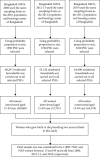Determinants and Trends of Health Facility Delivery in Bangladesh: A Hierarchical Modeling Approach
- PMID: 35937411
- PMCID: PMC9355761
- DOI: 10.1155/2022/1359572
Determinants and Trends of Health Facility Delivery in Bangladesh: A Hierarchical Modeling Approach
Abstract
Background: Most maternal deaths occur during childbirth and after childbirth. This study was aimed at determining the trends of health facilities during delivery in Bangladesh, as well as their influencing factors.
Methods: This study used secondary data from three Bangladesh Multiple Indicator Cluster Surveys (MICSs) in 2006, 2012-13, and 2019. The study's target sample was those women who gave birth in the last two years of the survey. A two-level logistic regression was applied to determine the effects on health facility delivery separately in these two survey points (MICSs 2012-13 and 2019).
Results: The results show that the delivery of health facilities has increased by almost 37.4% in Bangladesh, from 16% in 2006 to 53.4% in 2019. The results of two-level logistic regression show that the total variation in health facility delivery across the community has decreased over recent years. After adding community variables, various individual-level factors such as women with secondary education (OR = 0.55 in 2012-13 vs. OR =0.60 in 2019), women from middle wealth status (OR = 0.49 in 2012-13 vs. OR = 0.65 in 2019), religion, and child ever born showed a strong relationship with health facility delivery in both survey years. At the community level, residents showed significant association only in the 2012-13 survey and indicated a 43% (OR = 1.43 for 2012-13) greater availability of health facilities in urban residences than in rural residences. Using media showed a highly significant connection with health facility delivery in both years as well as an increasing trend over the years in Bangladesh (OR = 1.19 in 2012-13 vs. OR = 1.38 in 2019). However, division, prenatal care, and skilled services all contribute greatly to increasing the delivery of health facilities in Bangladesh.
Conclusions: The results of this study suggest that policymakers need to pay attention to individual and community-level factors, especially women's education, poverty reduction, and adequate prenatal care provided by well-trained caregivers.
Copyright © 2022 Samia Kabir et al.
Conflict of interest statement
The authors declare that they have no conflict of interest.
Figures
Similar articles
-
Individual and community-level factors associated with skilled birth attendants during delivery in Bangladesh: A multilevel analysis of demographic and health surveys.PLoS One. 2022 Jun 29;17(6):e0267660. doi: 10.1371/journal.pone.0267660. eCollection 2022. PLoS One. 2022. PMID: 35767568 Free PMC article.
-
Factors associated with the utilization of institutional delivery services in Bangladesh.PLoS One. 2017 Feb 13;12(2):e0171573. doi: 10.1371/journal.pone.0171573. eCollection 2017. PLoS One. 2017. PMID: 28192478 Free PMC article.
-
Does unintended pregnancy have an impact on skilled delivery care use in Bangladesh? A nationally representative cross-sectional study using Demography and Health Survey data.J Biosoc Sci. 2021 Sep;53(5):773-789. doi: 10.1017/S0021932020000528. Epub 2020 Sep 14. J Biosoc Sci. 2021. PMID: 32924894
-
Individual and community level factors associated with health facility delivery: A cross sectional multilevel analysis in Bangladesh.PLoS One. 2019 Feb 13;14(2):e0211113. doi: 10.1371/journal.pone.0211113. eCollection 2019. PLoS One. 2019. PMID: 30759099 Free PMC article.
-
Progress in the utilization of antenatal and delivery care services in Bangladesh: where does the equity gap lie?BMC Pregnancy Childbirth. 2016 Jul 29;16(1):200. doi: 10.1186/s12884-016-0970-4. BMC Pregnancy Childbirth. 2016. PMID: 27473150 Free PMC article.
Cited by
-
Individual- and community-level factors associated with the presence of adequate iodized salt in households in Bangladesh: a multilevel modelling approach.Int Health. 2025 Jan 3;17(1):49-61. doi: 10.1093/inthealth/ihae016. Int Health. 2025. PMID: 38344755 Free PMC article.
-
Clustering of home delivery in Bangladesh and its predictors: Evidence from the linked household and health facility level survey data.PLOS Glob Public Health. 2024 Feb 15;4(2):e0002607. doi: 10.1371/journal.pgph.0002607. eCollection 2024. PLOS Glob Public Health. 2024. PMID: 38359056 Free PMC article.
-
Factors associated with institutional delivery in south Asian countries: evidence from five recent demographic and health surveys.Res Health Serv Reg. 2025 Aug 1;4(1):11. doi: 10.1007/s43999-025-00071-3. Res Health Serv Reg. 2025. PMID: 40748514 Free PMC article.
-
Individual and community-level factors associated with discrimination among women aged 15-49 years in Bangladesh: Evidence based on multiple indicator cluster survey.PLoS One. 2023 Jul 26;18(7):e0289008. doi: 10.1371/journal.pone.0289008. eCollection 2023. PLoS One. 2023. PMID: 37494354 Free PMC article.
-
Comparing Folic Acid Interventions and Arsenic Reduction Strategies for Neural Tube Defect Prevention in Bangladesh: A Systematic Review and Decision Analysis.Birth Defects Res. 2025 Jun;117(6):e2494. doi: 10.1002/bdr2.2494. Birth Defects Res. 2025. PMID: 40552686 Free PMC article.
References
-
- UNICEF. Maternal mortality - UNICEF DATA. UNICEF DATA [Internet] 2017 [cited 29 Jul 2021]. Available: https://data.unicef.org/topic/maternal-health/maternal-mortality/
MeSH terms
LinkOut - more resources
Full Text Sources




